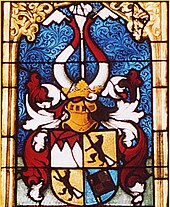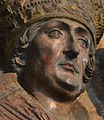Lorenz von Bibra
Lorenz von Bibra (* 1459 in Mellrichstadt ; † February 6, 1519 in Würzburg ), Duke in Franconia, was provost of the cathedral and from 1495 until his death in 1519 Prince-Bishop of Würzburg . He is a contemporary of Maximilian I (1493–1519), Emperor of the Holy Roman Empire, to whom Lorenz also served as an advisor.
Lorenz in the family context
Lorenz was a member of the noble Franconian family von Bibra . His father was Hans von Bibra, who was employed in the service of the Würzburg monastery as a bailiff in Mellrichstadt . Lorenz was most likely born there too. He was the second son from his third marriage to Agnes von Schenkenwald .
Lorenz von Bibra appointed many of Bibra's relatives to important positions in the Diocese of Würzburg. His successor Konrad II von Thüngen followed this example to an even greater extent. There were other church dignitaries within the family, e. B. Conrad III. von Bibra , also Prince-Bishop of Würzburg (1540–1544). Lorenz's half-brother, Wilhelm von Bibra , was the papal envoy. Heinrich von Bibra (1711–1788) was Prince Bishop and Abbot in Fulda.
Biographical data
Lorenz von Bibra attended the school of the Vessra monastery and the universities in Heidelberg , Erfurt and Paris . Lorenz appears in the course of his career as a clergyman in the cathedral chapter of Mainz, where he enjoyed the trust of Bishop Berthold von Henneberg and was entrusted with various tasks, and in addition to the Würzburg cathedral chapter also in the Cologne cathedral chapter.
As bishop he wrote a letter of recommendation to Pope Innocent VIII in 1487 for his half-brother Wilhelm , who was appointed to the Vatican as envoy by Archbishop Hermann IV of Cologne . In 1490 Wilhelm fell ill on his return from Rome as an envoy from Emperor Friedrich .
On May 12, 1495, Lorenz von Bibra was elected Bishop of Würzburg . Lorenz was a popular and respected ruler. He was often called on to resolve disputes as an arbitrator. As a supporter of humanism in Germany and as a person of the Renaissance , he tried to reform the Catholic Church. The diocese of Würzburg experienced a financial heyday under his aegis. In 1502 he issued a medical ordinance for the bishopric in Latin and German, which regulated, among other things, the behavior of pharmacists and doctors as well as the payment of medical services.
In terms of alliance politics, Lorenz, like his predecessors, renewed treaties against the margraves of the Hohenzollern family . Through the alliance with the princes of Lower Bavaria and the Electoral Palatinate (see House Wittelsbach ), the Würzburg Monastery was involved in the Landshut War of Succession . After the Count Palatine were defeated, Lorenz looked for a new ally and found him in 1508 in the Elector Friedrich von Sachsen . The Swabian Federation also offered itself to him as an ally; Lorenz rejected this offer. On the other hand, he promoted the reconciliation of the brothers Ludwig V of the Palatinate and Friedrich II , Elector of the Palatinate , with Duke Ulrich von Württemberg . This formed an opposing force against the Swabian Federation , the so-called "Kontrabund". In the impending war between the contrabund on the one hand and the Swabian Confederation, Nuremberg and Bamberg on the other, the emperor tried to mediate. Margrave Kasimir tried to have one of his brothers appointed as coadjutor of Würzburg, which should pave the way for a later takeover of the diocese, but with which he could not prevail.
Lorenz von Bibra and Martin Luther
He often met with Martin Luther and got on well with him. Apparently in April 1518, just before Luther's disputes with the Catholic Church flared up, Lorenz died. Following the conference in Würzburg, Lorenz Luther offered his escort and wrote a letter of recommendation to the Duke of Saxony Friedrich the Wise stating that his dear Excellency did not want to let the pious man Doctor Martinus move away because he was doing injustice. Friedrich put this in the hands of Georg Spalatin . Frederick the Wise was the second most powerful man in the Holy Roman Empire and became Luther's greatest protector and promoter during the Reformation . The writing fueled speculation about Lorenz's sympathies for the Reformation.
Lorenz von Bibra and Riemenschneider

In contrast to his successor, Lorenz had good relations with the famous sculptor Tilman Riemenschneider , who was also mayor of Würzburg for a while. Lorenz commissioned him to change the new church in Bibra. Before 1519 he also commissioned Riemenschneider to make an epitaph altar for himself and his predecessor Rudolf II von Scherenberg in the cathedral of Würzburg . Lorenz von Bibra's tomb was not completed until 1522. Today the two grave monuments stand side by side, made of the same stone and with the same motif, but in two different styles, late Gothic and Renaissance.
Lorenz von Bibra and Trithemius
Johannes Trithemius (1462–1516) accepted the offer from Lorenz von Bibra in 1506 to become abbot of the Schottenkloster of Würzburg . The word steganography is derived from his book Steganographia , a treatise on cryptography and steganography disguised as a book on black magic . His 1518 book Polygraphia was the first printed book on cryptography.
coat of arms
The Prince-Bishop's coat of arms is quartered . Fields two and three take up the von Bibra family coat of arms. The gold coat of arms shows a soaring black beaver with a red tongue and a silver-scaled tail. The first field contains the Franconian rake for the diocese of Würzburg and the fourth field in blue a racing flag in red and silver for the duchy of Franconia .
See also
literature
- Wilhelm Freiherr von Bibra: History of the family of the Freiherrn von Bibra. 1870.
- Wilhelm Freiherr von Bibra: Contributions to the family history of the Reichs Freiherrn von Bibra, second volume. (vol. 2), 1882
- Enno Bünz , Wolfgang Weiß (ed.): Bishop Lorenz von Bibra (1495–1519) and his time - rule, church and culture in transition. Echter, Würzburg 2020, ISBN 978-3-429-05497-7 .
- Sebastian Göbl: Lorenz von Bibra . In: Allgemeine Deutsche Biographie (ADB). Volume 19, Duncker & Humblot, Leipzig 1884, pp. 174-178.
- Werner Wagenhöfer: The Bibra: Studies and materials on genealogy and ownership history of a Franconian lower nobility family in the late Middle Ages. Verlag Degener & Co, 1998, 699 pp. ISBN 3-7686-9147-0 .
- Alfred Wendehorst : The Diocese of Würzburg: Part 3. The series of bishops from 1455-1617. 1978, ISBN 3-11-007475-3 , pp. 51-72
- Alfred Wendehorst: Lorenz von Bibra. In: New German Biography (NDB). Volume 15, Duncker & Humblot, Berlin 1987, ISBN 3-428-00196-6 , p. 169 ( digitized version ).
Web links
- Lorenz von Bibra at vonbibra.net
- Tomb of Lorenz von Bibra
- Luther with Lorenz von Bibra ( Memento from February 12, 2013 in the web archive archive.today )
- Find Prince Bishops Bibra Murder
Individual evidence
- ^ Bruno Rottenbach: Würzburg street names. Volume 1, Franconian Society Printing Office , Würzburg 1967, p. 91 ( Bibrastrasse ).
- ^ Peter Kolb: The hospital and health system. In: Ulrich Wagner (Hrsg.): History of the city of Würzburg. 4 volumes, Volume I-III / 2 (I: From the beginnings to the outbreak of the Peasant War. 2001, ISBN 3-8062-1465-4 ; II: From the Peasant War 1525 to the transition to the Kingdom of Bavaria 1814. 2004, ISBN 3 -8062-1477-8 ; III / 1–2: From the transition to Bavaria to the 21st century. 2007, ISBN 978-3-8062-1478-9 ), Theiss, Stuttgart 2001–2007, Volume 1, 2001, p 386-409 and 647-653, here: p. 405.
- ↑ Gottfried Lammert: History of bourgeois life and public health care, as well as in particular the sanitary facilities in southern Germany. A contribution to the history of culture and medicine. Wunderling, Regensburg 1880, p. 282.
- ↑ Stefan Kummer : Architecture and fine arts from the beginnings of the Renaissance to the end of the Baroque. In: Ulrich Wagner (Hrsg.): History of the city of Würzburg. 4 volumes; Volume 2: From the Peasants' War in 1525 to the transition to the Kingdom of Bavaria in 1814. Theiss, Stuttgart 2004, ISBN 3-8062-1477-8 , pp. 576–678 and 942–952, here: pp. 578 f.
| predecessor | Office | successor |
|---|---|---|
| Rudolf II of Scherenberg |
Prince-Bishop of Würzburg 1495–1519 |
Konrad II of Thüngen |
| personal data | |
|---|---|
| SURNAME | Bibra, Lorenz von |
| BRIEF DESCRIPTION | Prince-Bishop of Würzburg |
| DATE OF BIRTH | 1459 |
| PLACE OF BIRTH | Mellrichstadt |
| DATE OF DEATH | February 6, 1519 |
| Place of death | Wurzburg |



